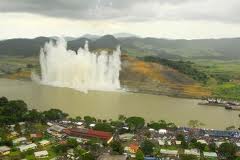 (Prensa.com) When called on stakeholders to develop the most important component of the expansion program of the Panama Canal, the Canal Authority (ACP) expected at least four companies were interested in the mega project that was conceived, and it was.
(Prensa.com) When called on stakeholders to develop the most important component of the expansion program of the Panama Canal, the Canal Authority (ACP) expected at least four companies were interested in the mega project that was conceived, and it was.
When the process was open, came four consortia and four qualified to participate in the tender for the design and construction of a third set of locks.
Consortia agglutinated 30 companies from 13 countries. At the end of the process, which took two years, following an assessment of technical skills, experience and financial capacity of enterprises, July 15, 2009 awarded the contract to United for the Channel Group, composed of Sacyr , SA, Spain; Impregilo SA, Italy, Jan de Nul of Belgium, and Constructora Urbana, SA, Panama.
Since that day, to date, have a little over two years and the expansion is in full swing. Millions of cubic meters of earth have been removed, changing the face of the strip for 97 years changed the history of the country and the course of the road has been widened and deepened by the work of thousands of workers who move through different construction sites in both the Pacific and the Atlantic.
The Panamanian climate and geology have made several plans to work more than one contractor has implemented or is implementing some of the components of the project, but is no stranger to any construction project, say administrators.
In fact, almost four years after the sonic explosion that marked the start of construction of the expansion program of the waterway, during the presidential administration of Martin Torrijos (2004-2009) – the project has an increase of 28% casts concrete at the site will be the third set of locks of the Atlantic are a fact, administrators of the waterway are prepared to absorb demand for services greater than that projected when the project was conceived, and the maritime industry is the expectation that for the ACP will be a change in trade patterns.
There has been little that has happened to the country’s most important asset, which in December 2011 to meet Panamanian administration 11 years and in that time has given contributions to the Treasury by about $ 400 million 6000.
To reach this stage of the project required the work of many and the concept of a bidding and contracting process that left no doubt, inside and outside the country.
HIRING
Adriano Espino, chief executive of the Construction Contract Administration of the ACP, led the team that was responsible for creating the model that the consortium would be selected to build the new set of locks. “It was a model of prequalification and bidding process after a non-negotiated best value,” says Espino.
“We did not want to say I like this proposal better than the other, the comparison in this case was difficult and what was intended was that each bid had its score alone, not because it was compared with the other,” he said.
To ensure that the assessment was made in this way, the evaluators were divided into three groups and each took over part of the proposal. The committees were set up and each established a plan and schedule of activities. Thousands of pages read, discussed plans, experts from around the world consulted. The defined term was four months and although not without setbacks, are met.
Espino details that had weekly coordination meetings to see how the program progressed, if they were on time or not, have to work Saturday or Sunday or overtime to meet schedule. “It was hard work, much stress, a lot of technology that companies have the ability to clarify the concepts that we had doubts, because ultimately these letters (e-mail communications with the bidders during the evaluation period) be part of this contract, the specifications and was a great responsibility to see how to spell, what answer, “he remarks.
But said there was no time during the crisis, did have some setbacks with the availability of advisors who were forced to make contracts “trouble”, which involved seeing how much they charge, when they could come and do “lobby.”
This, he says, even though each team of assessors had planned what kind of people could use at any given time and contacted them long before they need them.
Espino, a Santeña when not working for the ACP does in the field, acknowledges that it has much to be proud: The evaluation process, and thanks to the making of all proponents of the project were in accordance with the bidding but lost -none protested on the grounds that were rigged or the product of influences, and that is the person who has signed all the contracts for the expansion-about 5 billion dollars.
But if there is something that feels satisfaction is having the opportunity to meet so many experts during the evaluation process. Put in your own words, were people who would want suck all they had in mind.
“Sharing this information has been the greatest thing for me, taught me to be humble, to know the limitations you have, one is located and learn from others,” he said.
But there is more than the recruitment team can boast of the ACP, is that this prequalification and contracting model is being copied by others, including multilateral organizations.